The Water Cycle: The Endless Journey Of Water Across The World
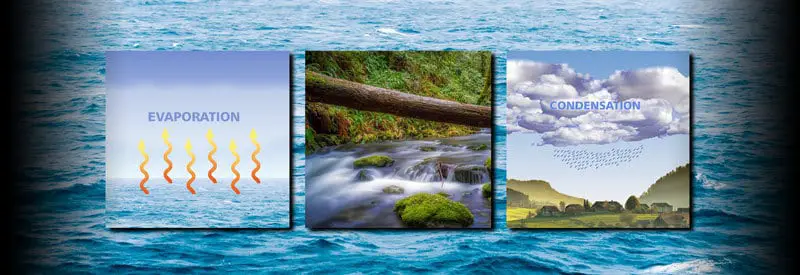
The movement of water is all around us. Rain, snow, and the clouds they form in are part of it. So are rivers, lakes, and the world's oceans, which contain over ninety percent of all water. It is known as the Water Cycle.
The Water Cycle is the constant movement of water in its different forms on a regional and global scale as it flows and transitions over land, in the oceans, and in the atmosphere. It includes all weather phenomena like precipitation, evaporation, condensation, sublimation, and transpiration.
No matter where you find water, whether it be in a vast lake in the mountains or a cloud high in the troposphere, it is part of the global movement of water.
Even in all its states, whether it be solid (ice), liquid (water), or gas (water vapor), it still forms part of this interconnected water movement.
All movement and every path that water follows on a local and global scale, are part of what is known as The Water Cycle.
This article will focus on explaining what The Water Cycle is, how it works, and its importance for all life on Earth.
Water Cycle Definition
The Water Cycle is a large and complex system with many moving parts that work together to form part of a network of water flow across the globe. Before one can start to delve deeper into its workings, a more detailed description of the water cycle is required.
What Is The Water Cycle?
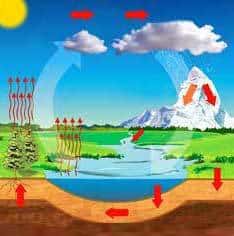
The Water Cycle is the constant movement of water in its various forms on a local and global scale as it flows or transitions over land, in the oceans, and the atmosphere.
This includes all related physical processes such as precipitation, evaporation, condensation, sublimation, and transpiration.
As you can see, it is a very broad description, and to really understand it, one will need to look at some of the more specific processes involved, both on a local and global scale.
Before we look at the steps involved in the creation of more specific water cycles, one should first establish a clear picture of the primary water sources (where the movement of water originated from.)
Sources Of Water
It is impossible to pinpoint exactly where a specific water cycle started by merely looking at the current phase in which the cycle is observed. What makes it even harder is that it is a never-ending process with no current start or endpoint.
What is certain, however, is that all processes and cycles need a primary source of water. By looking at the major water sources and where they are situated, one will get a much better idea of where and how some water cycles are set in motion.
Sea Water
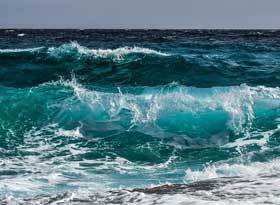
The world's oceans contain 97 percent of all water on Earth. This is saltwater, though, which makes it unsuitable for consumption in its natural form. But this does not disqualify it from being part of the water cycle.
Water can evaporate from the surface water, and since oceans cover 71 percent of the entire surface of the planet, it serves as an almost unlimited supply of moisture.
Fresh Water
Even though the ocean can provide fresh water indirectly (through processes we will discuss later in this post), it is not water that is available for immediate use. This leaves the planet with only 3 percent of fresh water, of which less than a third is readily available.
Polar Ice Caps
Of the 3 percent of freshwater on Earth, two-thirds are stored in the polar ice caps, and to a lesser extent glaciers, and snowpacks at high altitudes. The location and make-up of this solid form of water make it inaccessible for an extended period of time.
Dams, Rivers, And Reservoirs
Most of the remaining freshwater can be found in more traditional sources of freshwater we are familiar with, like dams, rivers, and reservoirs. They receive their water through precipitation, melting snowpacks, and smaller streams.
Groundwater And Aquifers
A small percentage of water infiltrates the ground, allowing groundwater to replenish and aquifers to fill. Some of these subsurface water sources find openings on the surface and escape into surface water. Others flow directly into the ocean through underground run-off.
How The Water Cycle Works
As mentioned earlier in this article, the water cycle as a whole is a complex mechanism with many smaller processes involved in the broader global movement of water. The best way to explain it is to look at some of these processes in isolation.
By using a relatively simple example of how the water cycle works and highlighting each critical process along the way, one will be able to get a clear understanding of how the process works as a whole.
As a starting point, water needs a primary source and mechanism to enable it to turn into its gaseous form, which will allow it to be transferred through the atmosphere. Two processes make this possible:
- Evaporation
- Transpiration
- Sublimation
Both of these processes fundamentally do the same thing. They allow water to be transformed into its gaseous state and escape into the atmosphere. The only difference is the source from where it turns into water vapor & the process through which it takes place.
Evaporation
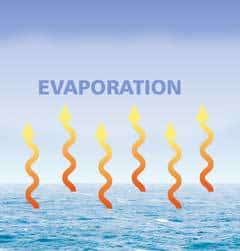
Evaporation occurs when the surface of a body of water in its liquid form is turned into water vapor. Primary sources include the ocean, dams, rivers, lakes, and other water bodies with their surfaces exposed to the atmosphere.
Evaporation is made possible by an increase in temperature. Solar radiation is usually the primary source of heat as the sun warms up the water's surface. The molecules in heated water become more energized, allowing it to break free from the surface as water vapor.
Transpiration
Evaporation is not the only source of water vapor. Depending on density and composition, vegetation provides a significant amount of water to the atmosphere. It occurs through a process called transpiration, where water vapor forms from the moisture created on leaves.
The roots of a plant or tree draw water from the ground. The moisture is then transported through the branches or stems into the leaves. The micro water droplets exit the leaves through small pores on their underside. From there, it escapes into the air as water vapor.
Sublimation
Sublimation is the transformation of water from its solid form (snow and ice) directly into water vapor without turning into a liquid first. This usually happens on high snow-covered mountaintops or other regions at altitude.
The heat from the sun is also responsible for this process, but since the process sometimes occurs in subzero temperatures, wind plays a big part, as it carries the small amounts of water molecules that evaporate away without leaving any liquid water behind.
Once in the atmosphere, water vapor gets subjected to a variety of variables that will determine how far and high it will travel, as well as where and when it will change back into its liquid or solid form.
Global wind movement can literally carry water vapor around the globe, but for the sake of this illustration, we will focus on a water cycle that is the result of local and prevailing winds.
Once water vapor enters the atmosphere, the water molecules start to rise up in the air due to the difference in pressure and the buoyant properties of the lighter vapor particles. (Water vapor molecules are lighter than the surrounding particles in the atmosphere.)
As it continues to gain altitude, the temperature continues to drop until the water vapor reaches dew point and condensation takes place.
Transportation
In this specific cycle, water vapor in the air gets carried towards the coast and inland by onshore winds. This horizontal movement of moisture is called transportation. A sea breeze is one example of the type of wind blowing inland from the ocean.
Condensation
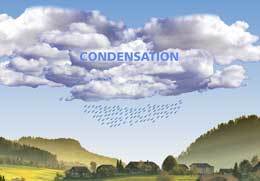
Condensation is the process through which water in its gaseous state (water vapor) gets turned back into its liquid (water) or solid (snow) form.
Both liquid and solid particles continue to grow in size until it becomes too heavy to stay in the atmosphere and fall to the ground in the form of precipitation.
Precipitation
Precipitation occurs when small water droplets or ice crystals grow and cling together. When they reach a certain size, they fall to the ground due to the Earth's gravity and the inability of wind flow in the atmosphere to maintain their buoyancy.
When the temperature is above freezing point, precipitation is in the form of raindrops. In subzero temperatures, precipitation takes the form of snowfall since the water vapor usually condensates directly into ice crystals (the solid form of water.)
Very often, even the global transport of water starts at a local level. The relatively simple cycle of water vapor from the ocean that gets blown over land where precipitation takes place is one such case and serves as the perfect example to explain the water cycle.
Depending on where and in which form precipitation occurs, the water is captured and stored in different forms:
- Snowpacks
- Surface Water
- Groundwater
All these forms of water sources play a crucial part in the water cycle and the supply of fresh water throughout various locations on land.
1) Snowpacks
Snow and other forms of solid precipitation fall and accumulate in regions with subzero temperatures to form snowpacks. Even in areas where you usually don't experience snowfall, you often see the mountaintops capped with snow due to their high altitude.
Snowpacks are a valuable source of fresh water. When temperatures start to rise, the snow melts and flows from mountains and other elevated regions into streams and rivers where it can be captured and stored.
2) Surface Water
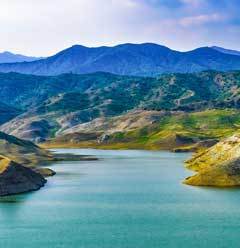
When rainfall occurs over land, it can fall directly into rivers, dams, and reservoirs. It can also fall on impermeable surfaces, where gravity will force it to flow via surface runoff areas into streams, rivers, and standing water bodies.
Sometimes the runoff areas direct the flow of water directly back into the ocean, or it may encounter soil or other porous surfaces where it gets absorbed as groundwater, which also serves an essential purpose.
3) Groundwater
A large percentage of water falls directly on land. If the surface it falls on is soil or a form of porous rock, the water gets absorbed and becomes groundwater. Below the surface, the moisture gets stored in aquifers.
The water table sits on top of the aquifer and serves as an indicator of the amount of water saturation in the ground. When the soil is fully saturated, the water table lies close to the surface. When the land is arid, it is situated far below the surface and may be unreachable.
Especially when saturated, very often, the groundwater does not stay in one place. It is absorbed by the roots of plants and trees, which is essential for their livelihood.
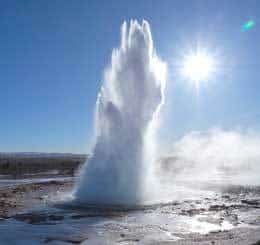
When situated at a gradient, groundwater will continue to flow through the porous ground. Where it finds a weakness or opening, it sometimes escapes to the surface in the form of springs and geysers or escapes directly into existing bodies of water like rivers and dams.
Groundwater may not escape to the surface at all but continue to flow in underground "rivers" where it will eventually return to the ocean.
All three forms of fresh water eventually find their way back to the ocean in some way, where the cycle starts all over again. And that is the water cycle in a nutshell.
Even in this fairly simplistic system we just discussed, there are variations and processes involved, with different outcomes that also play a part and have a significant influence on the larger cycle.
Variations In The Water Cycle
As just mentioned, the existing processes we highlighted throughout this post can have a variety of different outcomes and influences, even within a relatively simple water cycle like the one we focused on in this article.
Here are just a few variations that may occur within this system:
- Due to factors such as unexpected changes in wind movement, water that evaporates over the ocean can stay over the water, condensate, and form precipitation. The precipitation occurs over the ocean, and none of the moisture-filled air reaches land.
- Similarly, water vapor can escape from inland water bodies, rise and condensates over land. As a result, precipitation will occur over inland regions without ever reaching the ocean. A significant amount of water vapor stays in this cycle and does not immediately return to the sea.
- External weather systems can result in cold prevailing winds blowing over the ocean's water, preventing evaporation from occurring for sustained periods. As a result, areas close to the ocean can experience a water shortage, which can turn into drought conditions over time.
- Finally, water evaporating from water sources on land can be carried back to the ocean as a result of off-shore winds, where condensation and rainfall take place over water. It will also put pressure on remaining water resources in regions affected by this loss of precipitation.
These are just a handful of scenarios that can occur within a localized system. There are numerous processes and patterns that can occur as a result of local and global influences.
Conclusion
One clear conclusion that we can reach is that the water cycle is a very complex system that operates on a local and global scale. It is the result of the interaction between various weather systems and patterns that transforms and move water across the globe.
Although we used a relatively localized form of this cycle to explain how it works, it is clear to see that the water cycle doesn't operate in a vacuum. It was illustrated by showing some possible variations that may be the result of external or global weather behavior.
This article aimed to explain what the water cycle is and how it works by describing a typical local process that can also apply to different and more globalized forms of this cycle.
If you like to be informed whenever a new article is released, and also receive helpful tips & information, you can stay updated by simply following this link .
Until next time, keep your eye on the weather!

